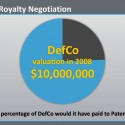 Good litigation graphics convey a message quickly and clearly. The example animation in today’s post supports an argument that plaintiff’s claim for a “reasonable royalty” in a patent case was unreasonable because the claim equaled the full value of the defendant company at the time of the “hypothetical negotiation” back in 2008.
Good litigation graphics convey a message quickly and clearly. The example animation in today’s post supports an argument that plaintiff’s claim for a “reasonable royalty” in a patent case was unreasonable because the claim equaled the full value of the defendant company at the time of the “hypothetical negotiation” back in 2008.
Here is a short (18-second) version of the animation with audio of how an attorney might argue the point to a jury.
Later in this post, you can see the “director’s cut,” which has a longer version of a sample argument ending in the animation.
When someone has infringed a patent, how does the jury determine damages? The relevant statute, 35 U.S.C. § 284, provides that the patent holder is entitled to “damages adequate to compensate for the infringement, but in no event less than a reasonable royalty for the use made of the invention by the infringer, ….”
The “Hypothetical Negotiation” in Patent Law
One way to prove damages under the statute is to become a time traveler, somewhat like Ebenezer Scrooge in “A Christmas Carol.” In the jury’s “time travel” for patent damages, the jury must imagine going back to a time just before infringement began, and listen in on a hypothetical negotiation for a “reasonable royalty” between the patent holder and the defendant. As the Federal Circuit has said, “the basic question posed in a hypothetical negotiation is: if, on the eve of infringement, a willing licensor and licensee had entered into an agreement instead of allowing infringement of the patent to take place, what would that agreement be?” LaserDynamics, Inc. v. Quanta Computer, Inc., 694 F.3d 51, 76 (Fed. Cir. 2012).
The Plaintiff’s Claim for $10 Million
The legal background should suffice to introduce our animation. The animation is modeled after a recent case in which we helped a patent defendant (the names, dates and amounts have been changed for this post). In our model situation:
- The defendant, DefCo, has been accused of starting to infringe the patent in 2008;
- The plaintiff, PatentCo, is seeking $10 million, which plaintiff claims is a reasonable royalty from a hypothetical negotiation in 2008;
- The defendant’s valuation in 2008 was $10 million.
The killer fact for defendant here is the comparison of plaintiff’s claim for $10 million versus the $10 million valuation of DefCo. DefCo’s argument is that it would never have agreed to pay all or nearly all of the value of its company for a license to PatentCo’s patent—this could not have been the result of the hypothetical negotiation.
Below is a longer version of a sample argument ending in the animation. The animation poses the rhetorical question, “What percentage of DefCo would it have paid to PatentCo?” The answer, of course, is something much less than the full value of DefCo.
In the comments, let us know what you think—does this animation work for you? Do you have other patent infringement war stories to share?
If you’d like to receive updates from this blog, please click to subscribe by email.

